- Editorial
- Abstract
- Introduction
- Piezoelectric Effect
- Bio-Tensegrity
- Fascia in Traditional Chinese Medicine (TCM)
- Myofascial Meridians and Energy Meridians
- Fascial Dysfunction
- Fascial Diagnosis – TCM Diagnosis
- Fascial Therapy
- Structural integration (Rolfing) for animals
- Acupuncture Therapy
- Embodiment
- VeFAS
- Conclusion
- References
Fascia Acupuncture System in Veterinary Medicine
Francesco Longo*
Fascia Acupuncture System in Veterinary Medicine
Submission:January 30, 2022; Published: February 10, 2022
*Corresponding author:Francesco Longo, DVM, Repr. Spec., Expert in TCM and Veterinary Acupuncture (IVAS Certified), VeFAS® Expert; Bologna, Italy
How to cite this article: Francesco Longo. Fascia Acupuncture System in Veterinary Medicine. J Complement Med Alt Healthcare. 2023; 11(5): 555822. DOI: 10.19080/JCMAH.2022.11.555822
- Editorial
- Abstract
- Introduction
- Piezoelectric Effect
- Bio-Tensegrity
- Fascia in Traditional Chinese Medicine (TCM)
- Myofascial Meridians and Energy Meridians
- Fascial Dysfunction
- Fascial Diagnosis – TCM Diagnosis
- Fascial Therapy
- Structural integration (Rolfing) for animals
- Acupuncture Therapy
- Embodiment
- VeFAS
- Conclusion
- References
Abstract
The fascia is a network that, permeating the whole organism, envelops the somatic and visceral structures, connecting the parts of the body to each other, determining their shape and offering support. This network organizes, separates and ensures the protection and autonomy of each muscle and viscera and at the same time brings them together in functional units by establishing spatial relationships and allowing communication between them. The band flows according precise paths called myofascial meridians which coincide with the paths of the of Traditional Chinese Medicine (TCM) energy meridians. The importance of this correspondence is both in the diagnostic phase, through the palpation of specific acupoints, and in the integrated therapeutic approach between fascial manipulation and acupuncture. The work introduces an integrated system, called Veterinary Fascia Acupuncture System (VeFAS®) which allows combining the functions of the fascia with the techniques of acupuncture.
Keywords: Veterinary Acupuncture; Fascia; Bio-Tensegrity; Rolfing; Embodiment; VeFAS
- Editorial
- Abstract
- Introduction
- Piezoelectric Effect
- Bio-Tensegrity
- Fascia in Traditional Chinese Medicine (TCM)
- Myofascial Meridians and Energy Meridians
- Fascial Dysfunction
- Fascial Diagnosis – TCM Diagnosis
- Fascial Therapy
- Structural integration (Rolfing) for animals
- Acupuncture Therapy
- Embodiment
- VeFAS
- Conclusion
- References
Introduction
Fascia: The fascia arises from the mesoderm and it can be divided into four functional categories.
Superficial fascia: (loose - areolar - panniculus) is a layer of loose and adipose connective tissue that surrounds the back and the extremities; it constitutes the most accessible and modifiable connective layer by the various manual techniques. It acts as a structure of thermoregulation, cushioning and connects the deep fascia with the body surface. The superficial fascia reverberates whatever is not working inside the body.
Deep fascia: (Axial – enveloping) extends deep into the body enveloping muscles, tendons, ligaments, and aponeurosis. Enables force transmission during muscle contraction. In the limbs this band flows more freely than in the trunk and is often composed of 2 - 3 sheets of dense connective tissue inside which there are collagen and elastic fibres which have the purpose of cushioning the loads during limb mobilization.
Meningeal band: protects the structures of the nervous system.
Visceral: Mediastinal fascia: it extends from the cranial base to the pelvis, it forms the lining of the body cavities and the structure to which the visceral organs are connected via suspensory ligaments; it also surrounds the large blood vessels (aorta, vena cava)[1].
- Editorial
- Abstract
- Introduction
- Piezoelectric Effect
- Bio-Tensegrity
- Fascia in Traditional Chinese Medicine (TCM)
- Myofascial Meridians and Energy Meridians
- Fascial Dysfunction
- Fascial Diagnosis – TCM Diagnosis
- Fascial Therapy
- Structural integration (Rolfing) for animals
- Acupuncture Therapy
- Embodiment
- VeFAS
- Conclusion
- References
Piezoelectric Effect
The essential feature of the fascia is its piezoelectric effect due to the predominant presence of collagen. The piezoelectric effect is present in almost all crystalline materials whose structure is made up of microscopic electric dipoles. At rest, these electric dipoles are arranged such that the faces of the crystal all have the same electric potential. When an external force is applied, which compresses the crystal, the structure of the same is deformed and the condition of electrical neutrality of the material is lost, whereby one face of the crystal is negatively charged and the opposite face is positively charged. The production of the potential difference generated by the compression induces the formation of an electrical signal, which is conveyed along the collagen fibres. Collagen is seen as a communicational network that conducts bioelectrical signals in the direction in which the fibres their self is oriented. The collagen molecules orient themselves like the needles of a compass along the piezoelectric charge line, i.e. along the voltage line, to create a preferential channel through which the bioelectric signals travel. Any mechanical force that causes structural deformation creates a piezoelectric effect that is then distributed around the connective tissue system. The cells detect this charge that is by read as a specific request that induces biochemical changes. Collagen is produced and metabolized according to the mechanical load that the tissue undergoes. If this undergoes a physiological mechanical load, the fibres are oriented in a serial manner, the bundles stretch and the fabric maintains its extensibility characteristics. If the tissue is subjected to excessive mechanical stress, the collagen gathers in much more compact bundles with loss of its extension capacity [2-3].
- Editorial
- Abstract
- Introduction
- Piezoelectric Effect
- Bio-Tensegrity
- Fascia in Traditional Chinese Medicine (TCM)
- Myofascial Meridians and Energy Meridians
- Fascial Dysfunction
- Fascial Diagnosis – TCM Diagnosis
- Fascial Therapy
- Structural integration (Rolfing) for animals
- Acupuncture Therapy
- Embodiment
- VeFAS
- Conclusion
- References
Bio-Tensegrity
Architect Richard Buckminster Fuller coined the term tensegrity in 1955; this word derives from the contraction of the English words tensile and integral and indicates the ability of an architectural system to stabilize itself mechanically with the play of tension and decompression forces that distribute and balance each other. The tensegrity structures are stable thanks to the balancing implemented by the entire structure and not by the individual components as it is able to adapt to the mechanical stresses by distributing them in the system. In 1998, the biologist Donald Ingber applied the concept of tensegrity at the cellular and biomolecular level, stating that the whole organism is a hierarchy of nested tensegrity architectures. Starting from the cytoskeleton, where the microtubules are the compressive structures and the microfilaments and intermediate filaments are the tensional components, up to the whole organism where the bones are the primary elements of compression and myofascia is the surrounding element of tension. Stephen Levin since 2007 has expanded the concept of tensegrity as bio-tensegrity to biological structures such as muscles, bones, ligaments, tendons, and cell membranes, thus configuring a dynamic anatomy for living organisms.
The musculoskeletal system, bones and joints are seen as floating structures within the soft tissues; the fascia generates a tensional force that holds the bones in the correct position and distance from each other and, in addition to stabilizing the structure, places it in a state of pre-stress. By applying the tensegrity principles to the musculoskeletal system it can be stated that by changing the balance of tension across the soft tissues it is possible to obtain a change in the relationship between the compressive bone elements. During the Fascia Research Congress, it was proposed the definition: “Fascia is a set of fibrous collagen tissues that are part of a broad system of transmission of tensional forces in the body” (Schleip R., 2012). This network organizes, separates and ensures the protection and autonomy of each muscle and viscera and at the same time brings them together in functional units by establishing spatial relationships and allowing communication between them. An internal dysfunction can manifest itself at the fascial level and, conversely, a myofascial problem can manifest itself at the organic level[4-5].
- Editorial
- Abstract
- Introduction
- Piezoelectric Effect
- Bio-Tensegrity
- Fascia in Traditional Chinese Medicine (TCM)
- Myofascial Meridians and Energy Meridians
- Fascial Dysfunction
- Fascial Diagnosis – TCM Diagnosis
- Fascial Therapy
- Structural integration (Rolfing) for animals
- Acupuncture Therapy
- Embodiment
- VeFAS
- Conclusion
- References
Fascia in Traditional Chinese Medicine (TCM)
According to the Nan Jing (The Classic of Difficult Issues -
written by Bian Que in the 5th century BC), there is a network of
meridians that runs within the membranes throughout the body
and connects all its parts. Pericardium (PC - Xin Bao Luo) manages
this network of membranes (Huang); the PC generates all the
covering structures: pericardium, pleura, peritoneum, and serosa
of the internal organs. This network is similar to the modern
concept of fascia. There are specific Huang acupoints that work
on the fascia:
• BL 43 (Gao Huang - it stimulates the production of red
blood cells when heated with moxa)
• BL 51 (Huang Men - it acts on the digestive system of all
animals and on the reproductive system of the mare)
• BL 53 (Bao Huang - it acts on the urinary tract of all
animals and on the reproductive tract of cats and dogs)
• KI 16 (Huang Men - it is considered the coordination
point of all membranes).
• CV 15 (Jiu Wei) regulates the flow of energy through
the membranes and connects the solar plexus and the brain
through the bands of the neck.
• CV 15 is linked to GV 1 (Chang Qiang), GV 9 (Zhi Yang),
last rib and diaphragm.
• The navel is considered the origin of the membranes and
CV 8 (Shen Que) is the acupoint that activates them through
the application of moxa alone or by pinching the skin very
gently (tuina manoeuvre: Nie Fa) (Figure 1)
• CV 8 promotes the development of the deep energies.

The insertion and rotation of the needle at the acupoints (perception of De Qi) produces a voltage in the fascia, which is transduced into an electric current due to the piezoelectric properties of the connective tissue. The electrons generated this way are led throughout the body along meridians (they are made up of proteins and mucopolysaccarides); when the stimulus arrives at the cells of a specific organ, the electric current is again transduced into chemical or mechanical energy necessary to restore physiological functioning on a molecular level. A cytoskeleton reshaping follows which induces the restoration of the tensional integrity of the system (tensegrity) [6-8].
- Editorial
- Abstract
- Introduction
- Piezoelectric Effect
- Bio-Tensegrity
- Fascia in Traditional Chinese Medicine (TCM)
- Myofascial Meridians and Energy Meridians
- Fascial Dysfunction
- Fascial Diagnosis – TCM Diagnosis
- Fascial Therapy
- Structural integration (Rolfing) for animals
- Acupuncture Therapy
- Embodiment
- VeFAS
- Conclusion
- References
Myofascial Meridians and Energy Meridians
The myofascial meridians are lines of traction that transmit the tension and movement through the fascia that surrounds the body that is wrapping by a three-dimensional fascial continuity that distribute tensions, efforts and compensations along these preferential tracks, thus contributing to the maintenance of the posture and the carrying out of the movements. In the application of manual therapies this holistic interpretation of the organism allows the therapist to have a global view of the body and intervene not only at the point of the insult but also, following the lines of traction, on the possible compensations, preventing or solving them. The concept of the myofascial meridian network may overlap with that of the energy meridians of TCM (Figures 2-5)[9-11]. The twelve principal meridians have coincidences and path overlaps with the myofascial meridians (Table 1).
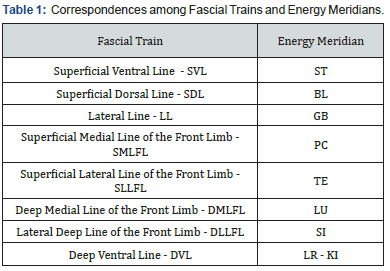
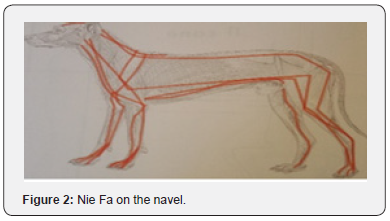
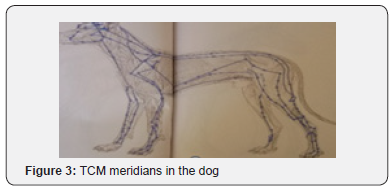
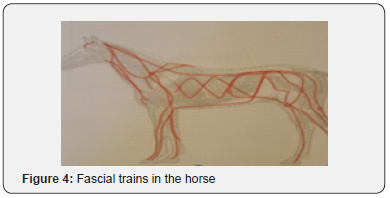
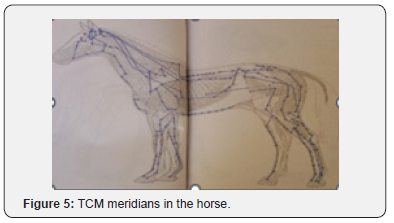
For each fascial line, it is possible to identify specific
acupoints on the corresponding meridians that are involved in the
modulation of fascial trains [12-15].
SVL/ST.
Acupoints: ST 1- ST 9 - ST 12 - ST 30 - ST 36 - ST 40 - ST 41 - ST
45.
SDL/BL.
Acupoints: BL 1 - BL 10 - BL 11 - B 40 - BL 62 - BL 67.
LL/GB.
Acupoints: GB 1 -GB 21 - GB 22 - GB 23 -GB 24 - GB 25 - GB 26
- GB 27 - GB 34 - GB 41 - GB 44.
SMLFL/PC.
Acupoints: PC 1 -PC 6 -PC 9.
SLLFL/TE.
Acupoints: TE 1 - TE 4 - TE 5 - TE 15 - TE 21- TE 23.
DMLFL/LU.
Acupoints: LU 1 - LU 7 -LU 11.
DLLFL/SI.
Acupoints: SI 1 - SI 3 - SI 8 -SI 10- SI 11 - SI 18 -SI 19.
DVL/LR – KI.
Acupoints: KI 1 - LR 1 - LR 3 - LR 8 - LR 12- LR 13 - LR 14 -KI
27- GV 20
- Editorial
- Abstract
- Introduction
- Piezoelectric Effect
- Bio-Tensegrity
- Fascia in Traditional Chinese Medicine (TCM)
- Myofascial Meridians and Energy Meridians
- Fascial Dysfunction
- Fascial Diagnosis – TCM Diagnosis
- Fascial Therapy
- Structural integration (Rolfing) for animals
- Acupuncture Therapy
- Embodiment
- VeFAS
- Conclusion
- References
Fascial Dysfunction
Fascial dysfunction is a process that leads to the reduction or loss of elasticity and mobility of the fascia. It may arise because of excessive or improper stress, traumas, and scars; there are alterations in the fascial structures and physiology, their sliding is reduced and hindered, and areas of connective thickening, adhesions, restraints, fibrosis may occur. Finally, aging and inactivity can also lead to changes in the structure and function of the fascia. These dysfunctions correspond to as many clinical patterns according to the TCM (Table 2).
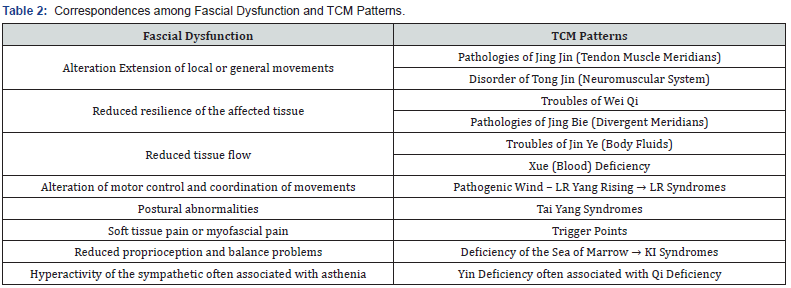
- Editorial
- Abstract
- Introduction
- Piezoelectric Effect
- Bio-Tensegrity
- Fascia in Traditional Chinese Medicine (TCM)
- Myofascial Meridians and Energy Meridians
- Fascial Dysfunction
- Fascial Diagnosis – TCM Diagnosis
- Fascial Therapy
- Structural integration (Rolfing) for animals
- Acupuncture Therapy
- Embodiment
- VeFAS
- Conclusion
- References
Fascial Diagnosis – TCM Diagnosis
The fascial diagnosis begins with a careful inspection aimed at evaluating the subject’s posture, perpendicularity, position and free mobility of the head, neck, trunk, tail and limbs, the animal is analysed while stationary and in movement, relationship with soli (grounding). Specifically in the horse, there are evaluated the conformation of the foot, the shoeing and the quality of its movement at different gaits (walk, trot, and gallop); the quality of the movement is indicator of integration among breathing, fluids, connective tissue. Particularly in the evaluation of the movement, it is essential to observe the relationship between flexors and extensors: in fascial terms, a body disorder will first manifest itself in the extensors. This inspection phase is fundamental in the evaluation of the so-called myofascial meridians, i.e., the global lines of tensegrity that cross the muscular surface of the body. Second phase is the auscultation with which we try to perceive any joint noises, intensity of breathing, bowel and any other sound that may be indicative of imbalance; it can perform an auscultative examination of the heart and lungs using a stethoscope. Palpation exam of the fascia, which takes place by anatomical sectors: head, neck, shoulders, forelimbs, back, abdomen, hind limbs, tail.
The stages of fascial diagnosis overlap with the TCM four diagnostic methods (Table 3).

Veterinary surgeons expert in Acupuncture always associate smelling exam with auscultation, i.e. the perception of particular smells coming from the animal’s body and indicative of its energetic condition. During the palpation phase, acupuncturist veterinary surgeons can probe specific diagnostic acupoints that provide further data on the physical and energy condition of the subject[16].
- Editorial
- Abstract
- Introduction
- Piezoelectric Effect
- Bio-Tensegrity
- Fascia in Traditional Chinese Medicine (TCM)
- Myofascial Meridians and Energy Meridians
- Fascial Dysfunction
- Fascial Diagnosis – TCM Diagnosis
- Fascial Therapy
- Structural integration (Rolfing) for animals
- Acupuncture Therapy
- Embodiment
- VeFAS
- Conclusion
- References
Fascial Therapy
A fascial restriction area leads to poor nourishment and oxygen supply at the cellular level, creating an environment where informational exchanges are difficult, favouring the accumulation of toxins and catabolites; furthermore the informational electromagnetic wave is blocked. This area of macro- and microscopic tissue alteration is an energetic cyst: an area in which the energy and informational flow is blocked or altered, preventing that part from integrating with the rest of the body. Through fascial therapy, it is possible to restore the “rails” on which this micro-current travels, allowing the free circulation of energy, in all its forms, and the maintenance of body harmony and health.
There are two main techniques of fascial therapy:
• Direct technique when this focal point is perceived, the
therapist’s concentration is focused on maintaining contact on
it in counter-resistance until perceiving the dissolution of the
resistance.
• Indirect technique the therapist follows the dysfunctional
tissues towards the path of least resistance until obtain the
tissue relaxation and free movement.
Sometimes for an external observer, the therapist and patient appear motionless, the movements may seem imperceptible, and the hands are in full contact with the tissue to follow the slightest variations in density.
Fascial techniques vary according to the stimulation on the
different fascial receptors:
• Light, short and tangential pressures activate the Pacini
mechanoceptors.
• Moderate and sustained stretching activates receptors of
Golgi.
• Rapid pressure, slight percussion or stretching read
activate the interstitial mechanoreceptors.
• Pressures, effleurage, percussion, stretching act on free
nerve endings. Manual therapy must take into account various
factors:
• Type of force to apply (compression, distraction,
distension)
• Degree of force to be applied (light, heavy, variable)
• Direction
• Duration
In therapies that comply with the law of Weber-Fechner, principle of minimum stimulus, the response induced by appropriate manual skill is turned inwards; in this way, the organism operates on itself by restructuring and inducing a reorganization of your configuration internal[12].
- Editorial
- Abstract
- Introduction
- Piezoelectric Effect
- Bio-Tensegrity
- Fascia in Traditional Chinese Medicine (TCM)
- Myofascial Meridians and Energy Meridians
- Fascial Dysfunction
- Fascial Diagnosis – TCM Diagnosis
- Fascial Therapy
- Structural integration (Rolfing) for animals
- Acupuncture Therapy
- Embodiment
- VeFAS
- Conclusion
- References
Structural integration (Rolfing) for animals
Rolfing takes its name from its creator, Ida Pauline Rolf (1896 - 1979) who initially defined her method: structural integration system. According to this theory, bodies live under the action of gravity and the elements of balance are bones and soft tissues (myofascia). Soft tissues held together bones, so when the myofascia is pushed back into place, the bones spontaneously reorient themselves. The plasticity of the body is directly connected to the myofascial system.
The three key concepts of structural integration are:
The body works more efficiently when the segments that
compose it (head, thorax, pelvis, legs) are organized in such a
way as to allow the animal’s centre of gravity to align with the
gravitational vertical;
• The fascia is the organ that guarantees the shape of the
body and the organization of its segments with respect to each
other;
• The body is a plastic medium, variable at any moment of
life.
The body of animals organizes itself around a point of equilibrium, the centre of gravity, but it is important to note that the centre of gravity refers to the centre of a static mass (stationary body) (Figures 6,7); for a moving body, the equilibrium point is a moving point that varies continuously. Structural integration combines manual therapy and specific movement exercises (in the case of the horse: barriers on the ground, trestles, work on two tracks, vaulting, gymkhanas, etc.; in the case of the dog, specific physiotherapy exercises). These techniques, carried out at different gaits and speed, are a real re-education in movement that serves to improve coordination and sports performance as changes are induced in the cortical mapping of the body in the space it occupies and changes in the engrams (brain memorization schemes). Ida Rolf says: “When the body starts to function properly, the force of gravity can flow; then, spontaneously, the body heals itself” [17-19].
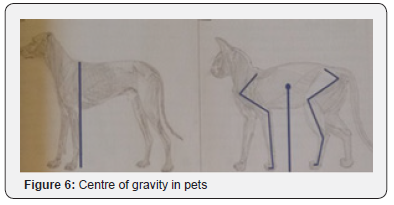
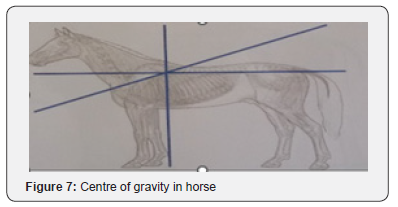
- Editorial
- Abstract
- Introduction
- Piezoelectric Effect
- Bio-Tensegrity
- Fascia in Traditional Chinese Medicine (TCM)
- Myofascial Meridians and Energy Meridians
- Fascial Dysfunction
- Fascial Diagnosis – TCM Diagnosis
- Fascial Therapy
- Structural integration (Rolfing) for animals
- Acupuncture Therapy
- Embodiment
- VeFAS
- Conclusion
- References
Acupuncture Therapy
In fascial therapy it is possible to proceed by sectors and
on these there are specific acupoints that can be stimulated
with a needle or tuina (Chinese massage) to enhance the fascial
technique:
• Head (Figure 8,9)
• Neck (Figure 10,11)
• Trunk (Figure 12,13)
• Fore Limbs (Figure 14,15)
• Hind Limbs (Figure 16,17)
• Tail (Figure 18,19).
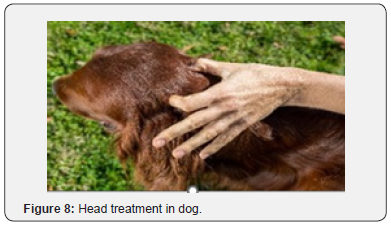
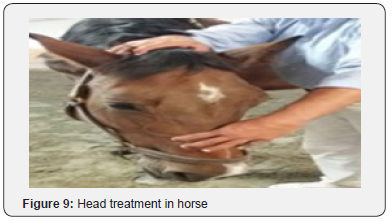
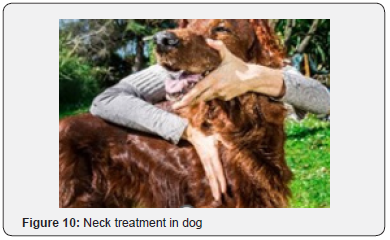
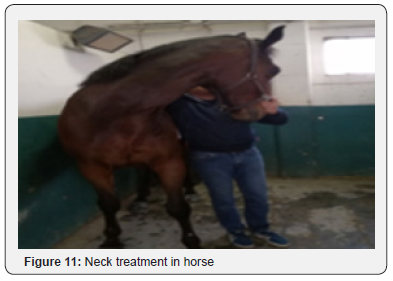
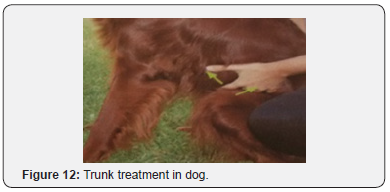
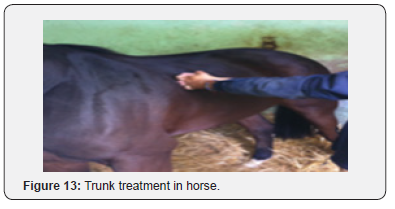


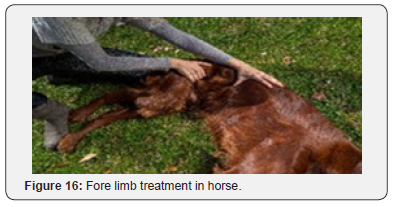

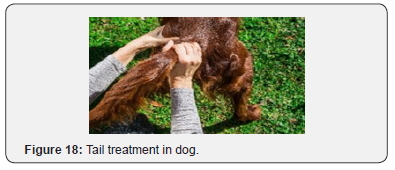
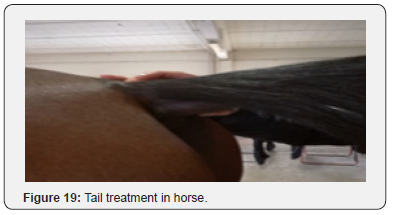
At the end of the VeFAS@ treatment, it is possible to check the animal’s relaxation through a general flexibility manoeuvre (Figure 20,21).
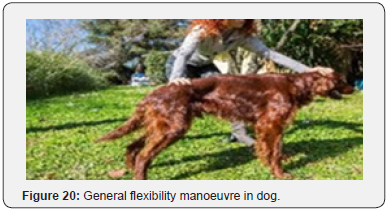

Based on the fascial meridians, it is possible to use the corresponding acupoints (mentioned above) with the aim of facilitating the flow of energy along the involved fascial train and able to eliminate the fascial restriction and treat the corresponding syndromes of TCM.
- Editorial
- Abstract
- Introduction
- Piezoelectric Effect
- Bio-Tensegrity
- Fascia in Traditional Chinese Medicine (TCM)
- Myofascial Meridians and Energy Meridians
- Fascial Dysfunction
- Fascial Diagnosis – TCM Diagnosis
- Fascial Therapy
- Structural integration (Rolfing) for animals
- Acupuncture Therapy
- Embodiment
- VeFAS
- Conclusion
- References
Embodiment
Embodiment means to be a body. When respiration, instinct,
nervous system, attention, intention are coherent, the animal
becomes one with its body. Behavioural (mental) activity is not
separate from the body. Being a body implies the self-regulating
balance of all parameters and the optimization of movement. The
realization of the embodiment allows:
• The body works most effectively when all its component
segments are organized in such a way as to allow the centre of
gravity to align with the gravitational vertical.
• The fascia is the organ that guarantees the shape of the
body and the organization of each body segment with respect
to the other.
• The body is on average variable in the different stages of
life.
According to Jacques Van Eijden (Somatic Movement Institute - Amsterdam): it is necessary to introduce bodily modalities to understand the world[22].
- Editorial
- Abstract
- Introduction
- Piezoelectric Effect
- Bio-Tensegrity
- Fascia in Traditional Chinese Medicine (TCM)
- Myofascial Meridians and Energy Meridians
- Fascial Dysfunction
- Fascial Diagnosis – TCM Diagnosis
- Fascial Therapy
- Structural integration (Rolfing) for animals
- Acupuncture Therapy
- Embodiment
- VeFAS
- Conclusion
- References
VeFAS
The veterinary medical act is enhanced by a specific integrated system of diagnosis and therapy between fascial technique and acupuncture has been developed (Longo F., Mastrangelo G., 2022). This system was called Veterinary Fascia Acupuncture System (VeFAS®). It can be applied in the clinic of pets and horses and in sports medicine (in this sector it helps to improve sports performance with excellent results and free from unwanted or side effects for animals).
- Editorial
- Abstract
- Introduction
- Piezoelectric Effect
- Bio-Tensegrity
- Fascia in Traditional Chinese Medicine (TCM)
- Myofascial Meridians and Energy Meridians
- Fascial Dysfunction
- Fascial Diagnosis – TCM Diagnosis
- Fascial Therapy
- Structural integration (Rolfing) for animals
- Acupuncture Therapy
- Embodiment
- VeFAS
- Conclusion
- References
Conclusion
According to scientific studies, the integration of fascial technique and acupuncture induces a better biomechanical organization, greater efficiency in neuro-motor coordination, stimulation of sensory and motor pathways, reduction of tension and chronic musculoskeletal pain, optimization of organic energy management (and resolutions of weakness and poor performance), reduction of anxiety states, improvement of wellbeing and general state of health.
- Editorial
- Abstract
- Introduction
- Piezoelectric Effect
- Bio-Tensegrity
- Fascia in Traditional Chinese Medicine (TCM)
- Myofascial Meridians and Energy Meridians
- Fascial Dysfunction
- Fascial Diagnosis – TCM Diagnosis
- Fascial Therapy
- Structural integration (Rolfing) for animals
- Acupuncture Therapy
- Embodiment
- VeFAS
- Conclusion
- References
References
- Brizhik L, Chiappini E, Stefanini P, Vitiello G et al. (2018) Modeling meridians within the quantum field theory, Journal of Acupuncture and Meridian Studies. JAMS 12(1): 29-36.
- Chenglin L, Xiaohua W, Hua X, Fang L, Ruishan D, et al. (2014) X-ray phase-contrast CT imaging of the acupoints based on synchrotron radiation, J Electron Spectros Relat Phenomena 196: 80-84.
- König HE, Liebich HG (2001) Anatomie der Haussäugetiere, Schattauer GmbH.
- Janssens L, Still J (1995) Acupuncture points and meridians in the dog, Satas Edition.
- Langevin HM, Bouffard NA, Badger GJ, Churchill DL, Alan K Howe AK, et al. (2006) Subcutaneous tissue fibroblast cytoskeletal remodelling induced by acupuncture: evidence for a mechanotransduction-based mechanism, J Cell Physiol 207 (3): 767-774.
- Langevin HM, Yandow JA (2002) Relationship of acupuncture points and meridians to connective tissue planes. The anatomical record (new anat.) 269: 257-265.
- Langevin HM, Churchill DL, Cipolla MJ, et al. (2001) Mechanical signaling through connective tissue: a mechanism for the therapeutic effect of acupuncture. FASEB J 15(12): 2275-2282.
- Longo F, Mastrangelo G (2019) Manuale di tecnica fasciale integrata nel cane, gatto e cavallo. CEA - Noi Edizioni, Milano.
- Longo F (2019) Myofascial trains and energy meridians in the sport horses: the original integrity of movement, Proceedings of the 45th International Veterinary Acupuncture Society (IVAS) Congress, Wroclaw.
- Longo F (2018) Biophysical and myofascial clinical approach in tuina for sport horse, Proceedings of the 10th Anniversary Chi Europe TCVM conference, Madrid.
- Longo F (2014) Solitons and fascia in horse body: acupuncture and tuina working. Proceedings of the 40th International Veterinary Acupuncture Society (IVAS) Congress, Florence.
- Mastrangelo G (2018) Fascial techniques in the acupuncture session. Proceedings of the 19th International Seminar of Italian Veterinary Acupuncture Society (SIAV/ItVAS), Arezzo.
- Mastrangelo G (2017) Examination of the fascia. Proceedings of the 18th International Seminar of Italian Veterinary Acupuncture Society (SIAV/ItVAS), Bolzano.
- Mastrangelo G (2017) Fascial trains in the dog. Italian Veterinary Acupuncture Society (SIAV/ItVAS), Torino.
- Myers T (2014) Anatomy Trains: myofascial meridians for manual and movements therapists. Churchill Livingstone Elsevier, London.
- Schleip R, Findley T, Chaitow L, Huijing P (2012) Fascia: the tensional network of the human body. Churchill Livingstone Elsevier, Edinburgh.
- Tsong TY (1989) Deciphering the language of cells. Trends Biochem Sci 14(3): 89-92.
- Van Den Bosch E Gurey JY (1999) Acupuncture points and meridians in the horse, Van Den Bosch Publishing
- Zhou W, Benharash P (2014) Effects and mechanisms of acupuncture based on the principle of meridians, Journal of Acupuncture and Meridian Studies 7(4): 190-193.






























